It's been well over two years since Nvidia debuted its GTX 10-series video cards in mid-2016 with intermittent releases of more powerful models filling the gaps between then and now. Particularly, the GeForce GTX 1080 Ti took care of the enthusiast crowd when it dropped in March 2017, but its time as the top dog has come to an end with the launch of the RTX 20-series. Both the GeForce RTX 2080 and RTX 2080 Ti have launched alongside plans to rollout new graphics technology--ray tracing and deep learning supersampling (DLSS)--but they also boast even more raw power than the previous generation of video cards for PC gaming. The question we're exploring, in particular, is how much faster are Nvidia's new GPUs than their predecessors.
These cards come at a hefty cost, of course. The RTX 2080 Ti carries a suggested retail price of $1,000 USD while the Founders Edition (that comes straight from Nvidia) goes for $1,200. The RTX 2080 takes it down a notch with its suggested retail price of $700 and Founders Edition that costs $800. For this review, we have Founders Edition units for each card, provided by Nvidia, though SKUs from board partners will be available at launch.
Technical Details
GeForce RTX cards are powered by the Turing GPU architecture, and they offer more than just better efficiency for higher performance because of their three-pronged approach. Essentially, the Turing Streaming Multiprocessor (SM) takes care of traditional performance with better shaders and outputs 14 TFLOPS. The Tensor Core is an AI engine that can incorporate deep learning technologies into real-time graphics, which was previously only relegated to workstation GPUs. Lastly, the RT Core tackles real-time ray tracing. Last generation's Pascal GPU architecture is simply not capable of real-time AI and ray tracing.
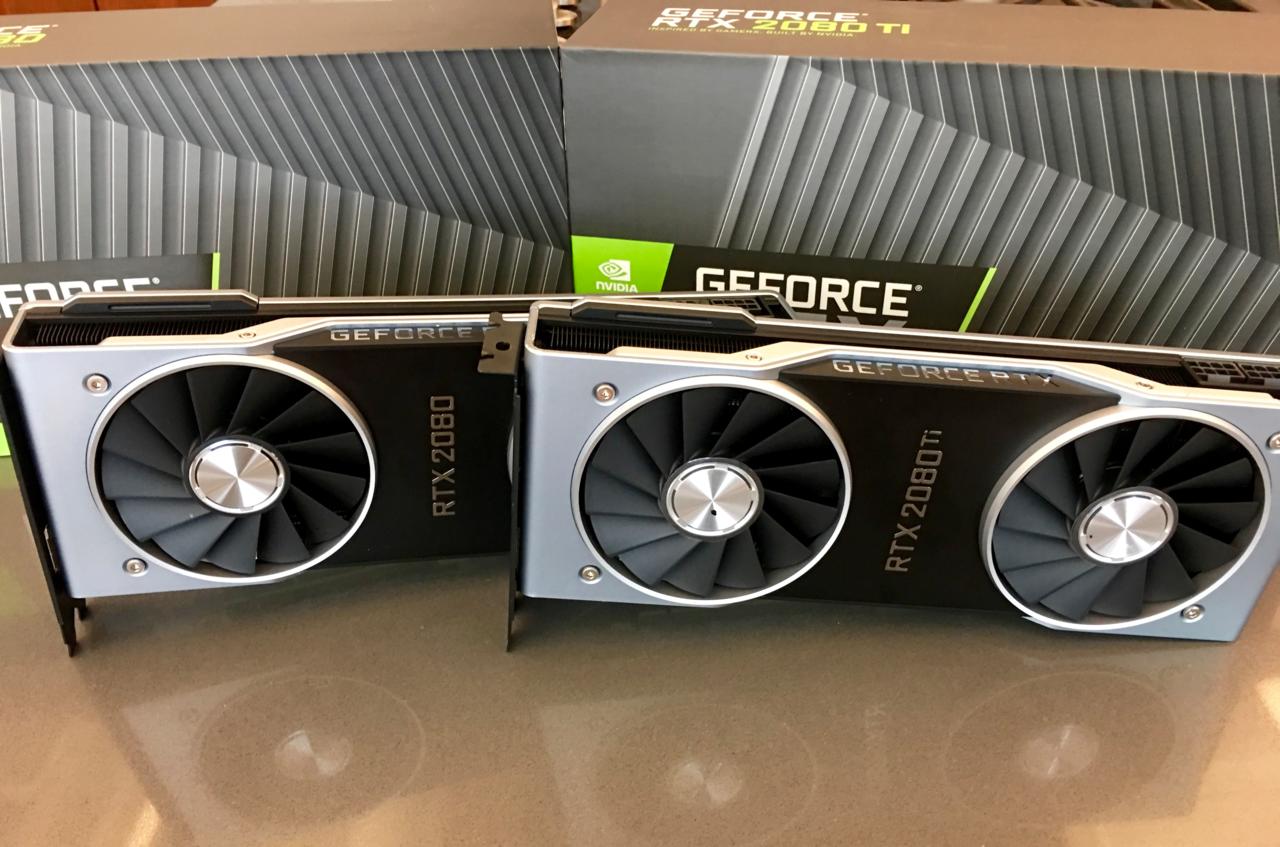
Nvidia has been pushing to get the word out on ray tracing in games, which fundamentally changes how lighting, shadows, and reflections can work. It's a more realistic representation of how light behaves and what it does to an environment; you can see ray tracing in action with Metro Exodus and Battlefield V. While this tech has been used in films, rendering in real-time for games hasn't been possible since PC gaming hardware was never built with it in mind--until now with the RT Core (hence the "RTX" moniker). The same can be said about artificial intelligence. DLSS is the first example of Tensor Cores at work; it's a new antialiasing method that uses a deep neural AI network to efficiently and accurately clean up jaggies between multiple frames with a negligible impact on performance.
Keep in mind that this is the first time consumer-level hardware has these capabilities and that it will take time for games to adopt and take advantage of it. As of now, 11 games are slated to incorporate real-time ray tracing, most of which have yet to launch. DLSS's relatively easier implementation means that more games can and will use the tech; 25 games are currently on the docket for DLSS, many of which are already out.
Fallout 4 Next Gen Update Comparison Fallout 4 Steam Deck Verified Gameplay ALIEN: Rogue Incursion - Announcement Teaser Trailer Stellar Blade - 13 Things I Wish I Knew S.T.A.L.K.E.R. 2: Heart of Chornobyl — Official "Not a Paradise" Trailer Sea of Thieves Season 12: Official Content Update Video Why Are Video Game Adaptations Good Now? | Spot On Manor Lords - Official Medieval City Builder/RTS Launch Trailer Honkai: Star Rail - "Then Wake to Weep" | Version 2.2 Trailer Devil May Cry: Peak Of Combat | Dante: Blazing Tempest Gameplay Trailer SAND LAND — Official Launch Trailer Stellar Blade - Hard Mode No Damage Gigas Boss Gameplay
Please enter your date of birth to view this video
By clicking 'enter', you agree to GameSpot's
Terms of Use and Privacy Policy
The chart below outlines the technical specifications between the three video cards used in our benchmarks: the GTX 1080 Ti, RTX 2080, and RTX 2080 Ti (all Founders Edition versions).
| RTX 2080 Ti | RTX 2080 | GTX 1080 Ti | |
|---|---|---|---|
| CUDA Cores | 4352 | 2944 | 3584 |
| Base Clock | 1350 MHz | 1515 MHz | 1480 MHz |
| Boost Clock | 1635 MHz | 1800 MHz | 1582 MHz |
| VRAM | 11 GB GDDR6 | 8 GB GDDR6 | 11 GB GDDR5X |
| Memory Speed | 14 Gbps | 14 Gbps | 11 Gbps |
| Memory Interface | 352-bit | 256-bit | 352-bit |
| Transistor Count | 18.9 Billion | 18.9 Billion | 12 Billion |
| Tensor Cores, FLOPS | 544, 114 | 368, 85 | N/A, N/A |
| RT Cores | 68 | 46 | N/A |
| Rays Cast | 10 Giga Rays/sec | 8 Giga Rays/sec | 1.1 Giga Rays/sec |
| RTX Performance | 78 Trillion RTX-OPS | 60 Trillion RTX-OPS | 11.3 Trillion RTX-OPS |
| ROPs | 88 | 64 | 88 |
| TDP | 260 W | 225 W | 250 W |
| MSRP (FE) | $1,000 ($1,200) | $700 ($800) | $600 ($700) |
Of course, the RTX 2080 Ti makes significant jumps over the GTX 1080 Ti on paper. But as you'll see in the test results, the RTX 2080 keeps up with the GTX 1080 Ti despite having fewer CUDA Cores and ROP units, among other specs. This is thanks to additional streaming multiprocessors, high clock speeds, and the overall efficiency of the Turing architecture.
Methodology
Our test bench consisted of all the high-end hardware we could muster to match the power of the video cards and mitigate any potential bottlenecks. For our CPU, we used an Intel Core i7-8700K liquid-cooled with an NZXT Kraken X62 all on a ASUS ROG Maximus X Hero motherboard. As for memory, we used 16GB (8GBx2) of HyperX Fury DDR4 RAM in dual-channel configuration and a Samsung 970 EVO NVMe m.2 solid-state drive for storage. Driver version 411.51 WHQL was used for all three video cards on the Windows 10 Professional 64-bit platform.
With our review, we're primarily aiming to test how the new cards handle gaming benchmarks at 4K (3840x2160) resolution and maximum graphics settings. Since not every PC gaming enthusiast has made the jump to 4K, we also ran the same benchmarks in 1440p (2560x1440); for those using high-refresh monitors, you'll want to know how many frames you'd be getting out of these cards. We've included eight different game benchmarks with three different cards between two resolutions. Conditions for each benchmark slightly differ, as you'll see in the charts and explanations below.
Benchmark Results
Shadow of the Tomb Raider
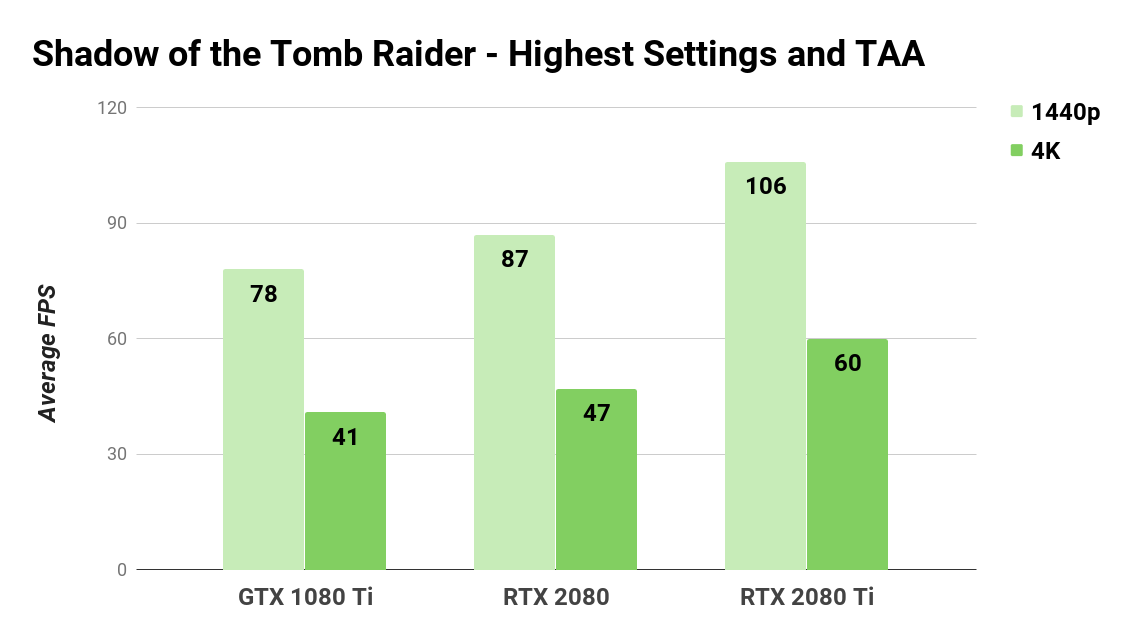
In Shadow of the Tomb Raider, we used the "Highest" graphics preset that includes settings like HBAO+ and temporal antialiasing (TAA or TXAA) along with shadows and level of detail maxed out. The built-in benchmark takes you through populated villages and vast tropical landscapes which encompasses environments and scenarios from the game itself.
At 4K, the RTX 2080 Ti achieves an average of 60 FPS on the dot while the RTX 2080 comes in with 47 FPS, representing a 46.3% and 14.6% increase over the GTX 1080 Ti, respectively. Going to 1440p, the RTX 2080 Ti is able to hit a 106 FPS average and the RTX 2080 gets 87 FPS; a 35.9% and 11.5% jump from the GTX 1080 Ti.
Ghost Recon: Wildlands

Ghost Recon: Wildlands' built-in benchmark consists of a fly-by that goes through two villages and a vast landscape while testing the impact of particle effects with fire and explosions. It's one of the more demanding benchmarks when using the "Ultra" graphics preset, which utilizes HBAO+ and temporal antialiasing.
The RTX 2080 Ti manages a 47 FPS average at 4K and the RTX 2080 gets a 39 FPS average, which shows a 23.7% and 2.6% improvement over the GTX 1080 Ti. At 1440p, both RTX cards manage over 60 FPS on average with a 22% and 3.4% increase from the 1080 Ti. Overall, the RTX 2080 performs very close to the 1080 Ti.
Middle-earth: Shadow of War
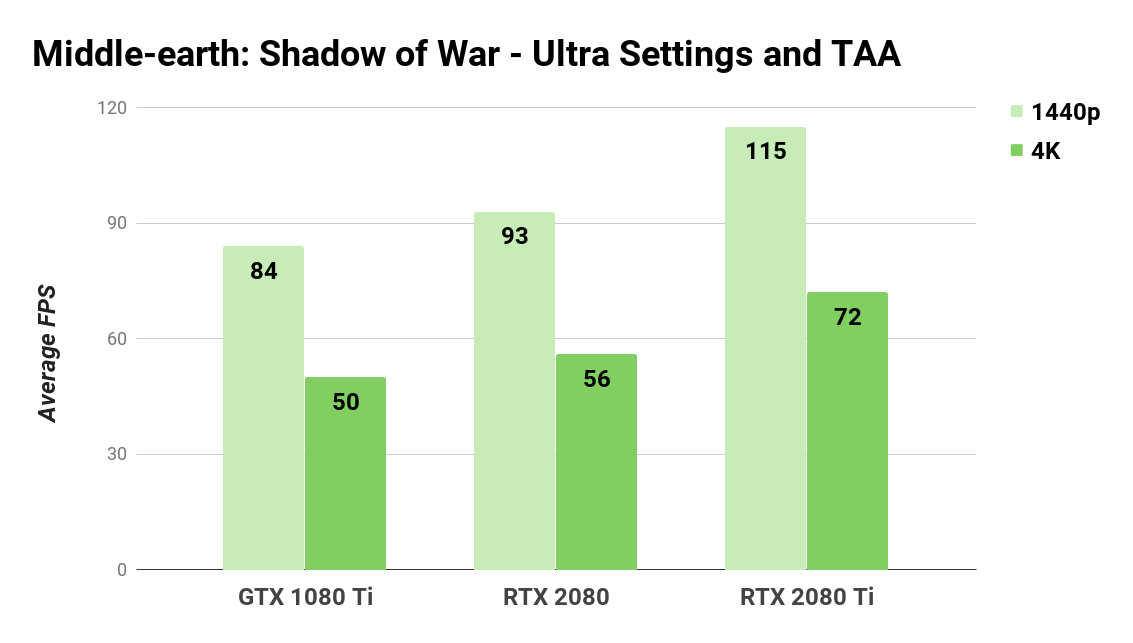
It may not be the best looking game on the roster but Middle-earth: Shadow of War has a neat benchmarking tool and plenty of graphics settings to crank up like tessellation, ambient occlusion, and temporal antialiasing. The test itself is a quick fly-by that captures vegetation, vast draw distance, and NPC crowds.
At 4K, the RTX 2080 Ti has no trouble staying above 60 FPS while the RTX 2080 comes very close to hitting 60 FPS on average. Based on our results, the new cards are 44% and 12% faster than the GTX 1080 Ti, respectively. When it comes to 1440p, both the RTX 2080 Ti and 2080 will be able to take advantage of high refresh rates, and run faster than the GTX 1080 Ti by 36.9% and 10.7%, respectively.
Final Fantasy XV
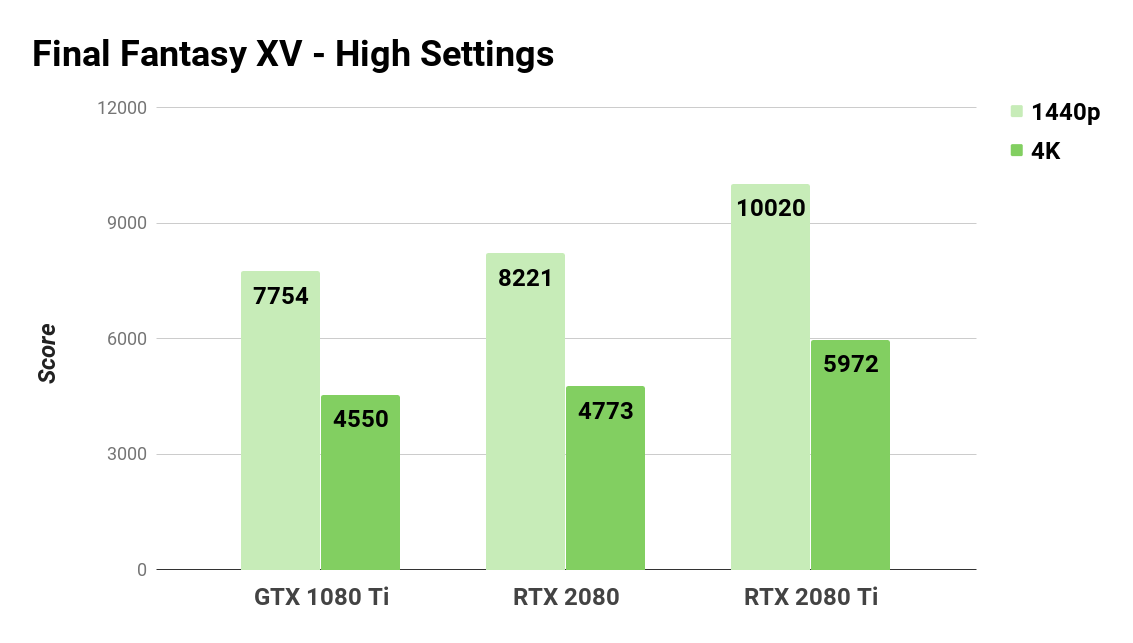
The PC port of Final Fantasy XV became a showcase for just how much eye candy you could pack into a game; it boasts tech like Nvidia Turf Effects, HairWorks, and VXAO. You actually don't need Final Fantasy XV to run the benchmark utility as it's a separate program available for free. It's a fairly long series of sequences that provides a comprehensive picture of the game's demands. One tricky thing is that performance is measured by a score rather than an explicit breakdown of FPS data. A general rule of thumb for this test is to simply divide the score by 100 to get a rough estimate of the your average FPS.
With that in mind, the RTX 2080 Ti is able to hit about 60 FPS on average at 4K with the highest graphics settings while the RTX 2080 clocks in around 48 FPS. The scores show a respective increase of 31.3% and 5% over the GTX 1080 Ti. With 1440p, the RTX 2080 Ti and 2080 can certainly take advantage of high refresh rates and represent a 29.2% and 6% performance boost over the GTX 1080 Ti.
Hitman
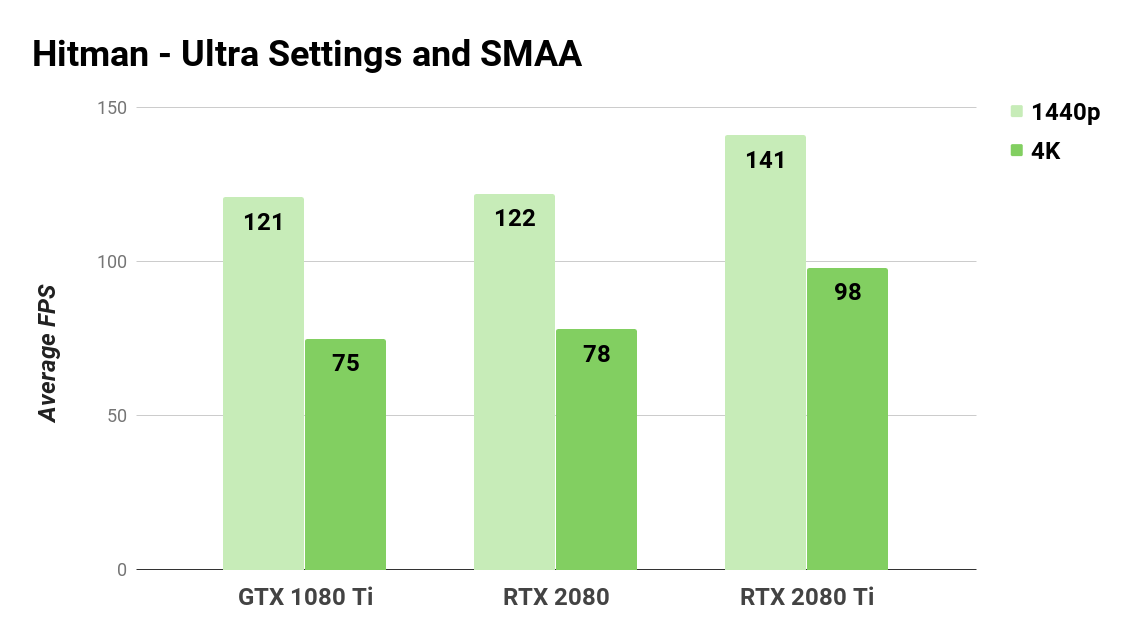
Hitman from 2016 is on the lower end in terms of graphically demanding games, but its built-in benchmark tool helps give a little more context as to how efficient Agent 47 can assassinate his targets. The test flies through different sections of the Paris level which includes plenty of crowds and lighting effects since this does take place during a fashion show.
All cards are more than capable of handling 4K with max settings since they're well above the 60 FPS average mark. Even at 1440p, each card excels and are able to take advantage of high refresh rate monitors. Performance is nearly identical between the RTX 2080 and GTX 1080 Ti.
Grand Theft Auto V
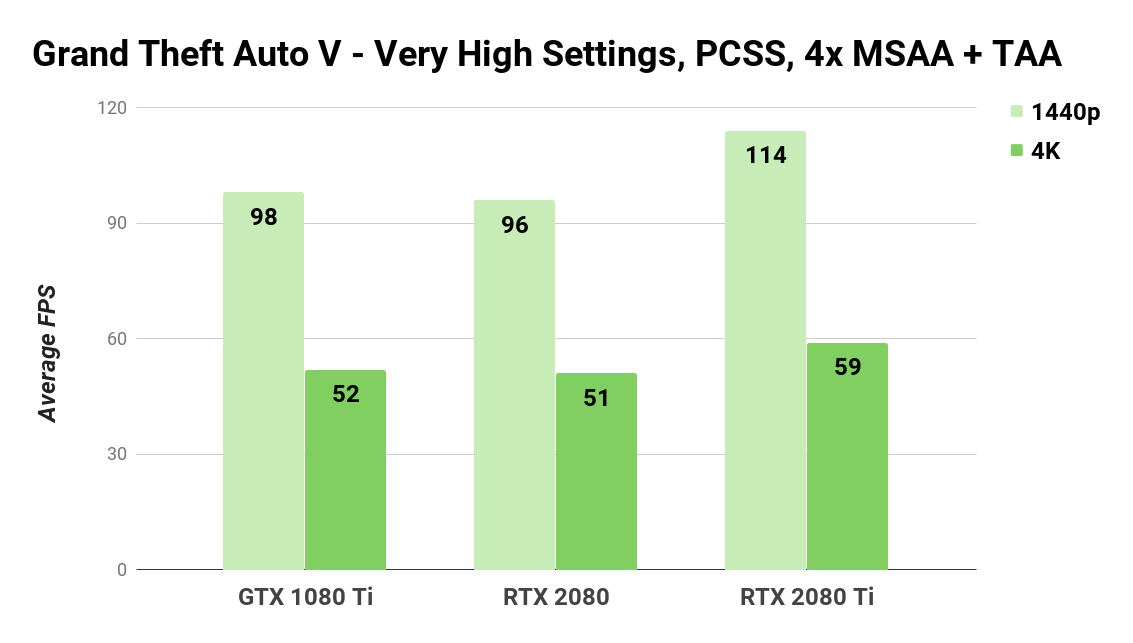
The PC version of Grand Theft Auto V can be overwhelming when it comes to testing since there aren't any graphics presets, but a plethora of options to choose from. Here, we put every quality setting to Very High, used Nvidia PCSS shadows, and 4x MSAA alongside TAA (the highest MSAA setting allowed to combine with TAA). GTA V's benchmark tool performs five separate runs that test out different scenarios. For the numbers in our graph, we averaged the FPS of each run.
Using 4K resolution and all these fancy settings, the RTX 2080 Ti pretty much nabs a 60 FPS average, showing a 13.5% improvement over the GTX 1080 Ti--the RTX 2080 essentially stay neck-and-neck with the 1080 Ti, which is also true in our 1440p test. Those with a high refresh rate monitor should be happy to know that the RTX 2080 Ti is more than capable of taking advantage of the extra hertz as well.
Deus Ex: Mankind Divided
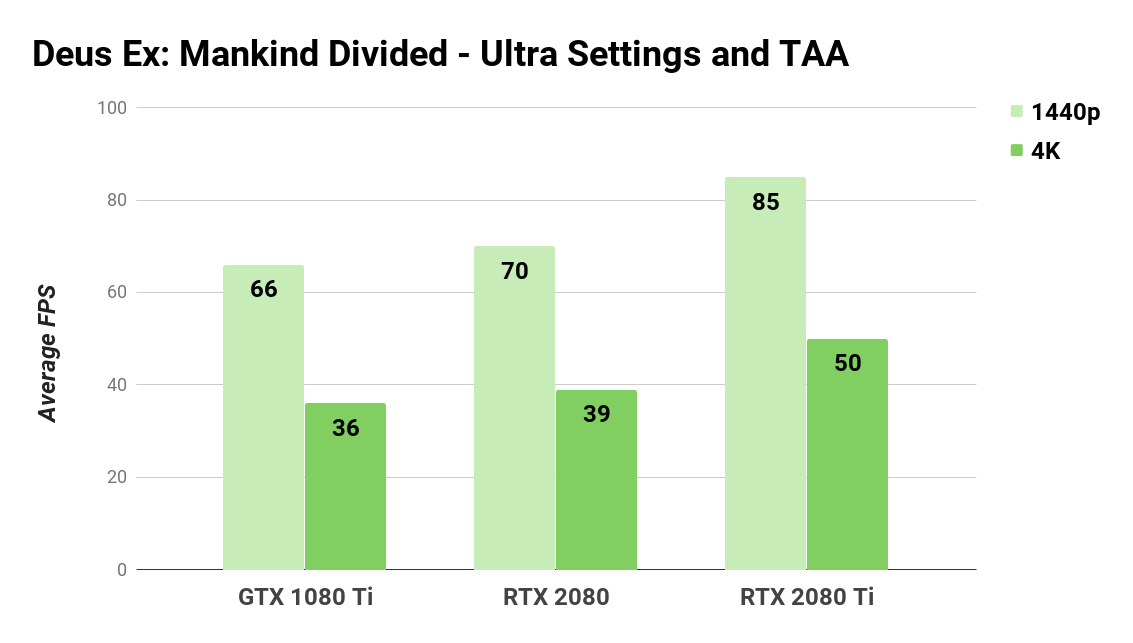
Deus Ex: Mankind Divided can be a heavy hitter. And when using the "Ultra" graphics preset, even the best video cards have trouble hitting 60 FPS in 4K. We disabled MSAA as it's not necessary for these high resolutions, especially when we're already using TAA. The built-in benchmark goes through a fairly contained marketplace within the Golem City chapter.
Even though the RTX 2080 Ti only hit an average of 50 FPS in 4K, it represents a 38.9% improvement over the GTX 1080 Ti. In 1440p, the new card is able to maintain an 85 FPS average; a 28.8% increase. The RTX 2080 shows slight improvements from the GTX 1080 Ti, giving an 8.3% and 6.1% bump in 4K and 1440p, respectively.
Metro: Last Light
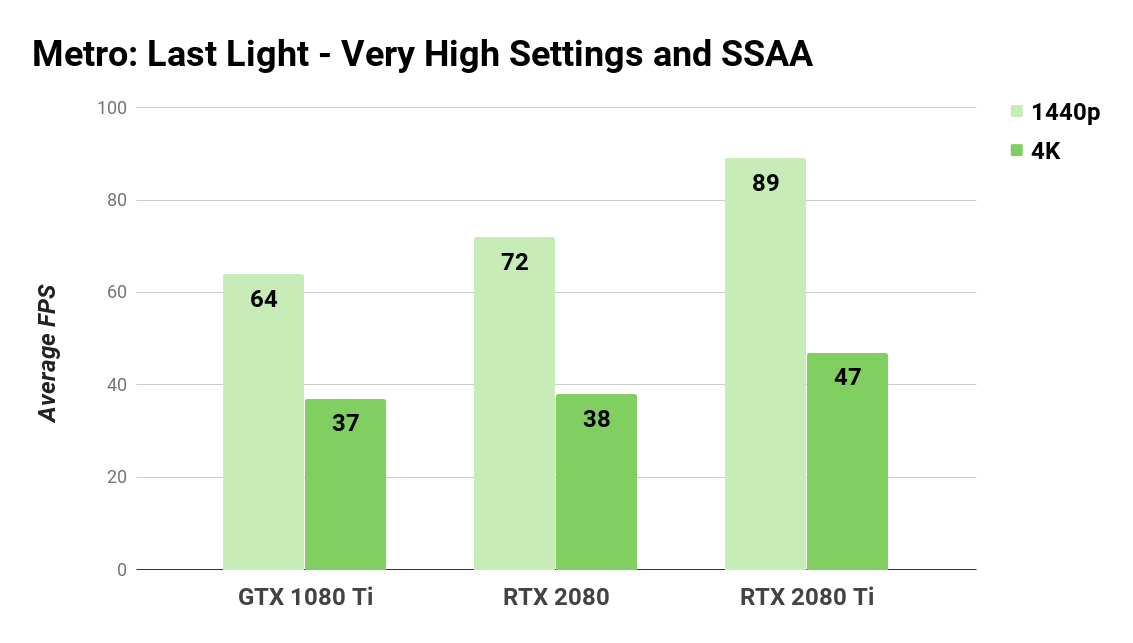
The Metro series has always been a marquee game for pushing PC hardware to their limits. Even being five years old at this point, it can still stress test your system when you tack on the resource-heavy SSAA setting.
The RTX 2080 Ti is able to get an average of 47 FPS while the RTX 2080 averages 38 FPS, close to the GTX 1080 Ti. If you're on a 1440p display, feel free to use SSAA as each card average well above 60 FPS. At this resolution, we see the RTX 2080 Ti and 2080 pull away from the 1080 Ti with a 39.1% and 12.5% improvement. Without SSAA on, all these cards provide plenty of juice to run Metro: Last Light smoothly.
Temperatures and Overclocking
| Video Card | Idle Temp | Load Temp | Peak GPU Clock |
|---|---|---|---|
| RTX 2080 Ti | 31 C | 77 C | 1875 MHz |
| RTX 2080 | 30 C | 74 C | 1980 MHz |
| GTX 1080 Ti | 36 C | 84 C | 1886 MHz |
Thanks to the video card utility EVGA Precision X1, we were able to closely monitor each GPU's idle temperatures, load temperatures, and core clock speed during testing. The GTX 1080 Ti is infamous for running hot and hits a peak load temp of 84 C--thankfully, both RTX cards run cooler with the 2080 peaking at 74 C and 2080 Ti peaking at 77 C.
Core GPU clock speeds varied throughout testing and each card was able to adjust itself according to run at peak efficiency. The RTX 2080 Ti showed the most room for higher clock speed by reaching 1875 MHz, which represents a 38.9% and 14.7% increase over stock and boost speeds, respectively. The RTX 2080 peaked at 1980 MHz, which is a 30.7% and 10% increase from its base clock boost clock. In these tests, the GTX 1080 Ti was able to run with clocks 27.4% and 19.2% faster than its base and boost speeds.
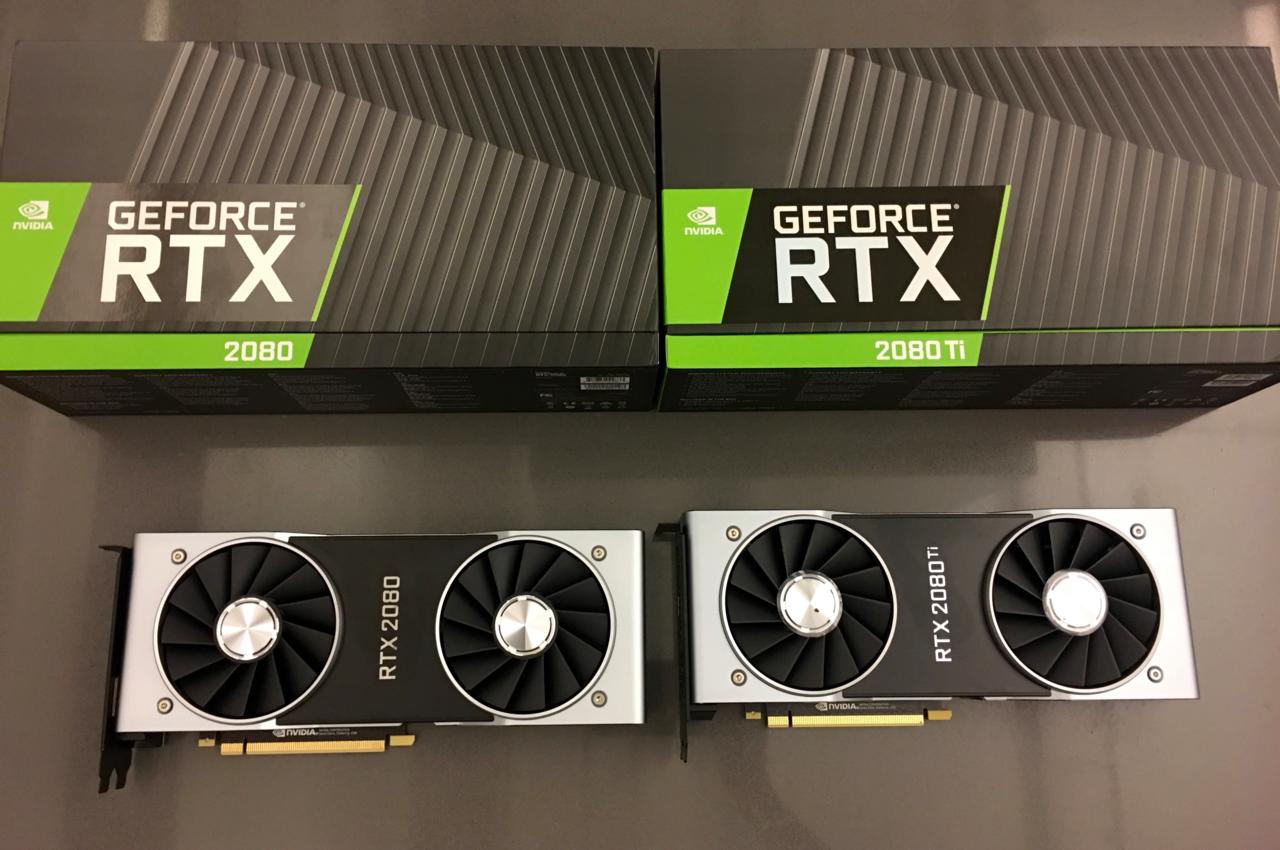
Verdict
So, to answer the main question posed at the top, can Nvidia's new video cards pull off 4K 60 FPS in the most demanding games out now using the highest graphics settings? The RTX 2080 Ti certainly can in most cases, and when it can't, it sure comes close. Its slightly lesser counterpart RTX 2080 isn't a slouch by any means either; it largely performs closer to the GTX 1080 Ti when it comes to in-game FPS using equal settings, but edges it out in most games.
That said, the Turing architecture paves the way for innovations in 3D graphics, which is what makes the RTX 20-series truly stand out. You'll be getting a whole lot more than just pure performance with the RTX 2080 and RTX 2080 Ti in the future since they're designed to execute real-time ray tracing and AI-based antialiasing, which previous cards just cannot handle.
If you're looking for the definitive card for 4K performance, the wildly impressive RTX 2080 Ti will be your best bet, but it's a high asking price at $1,000 to $1,200. Unless you're dead-set on maxing everything out at 4K or want to be an early adopter of new graphics tech, the RTX 2080 Ti is a bit much. The RTX 2080, for $700 to $800, is impressive in its own right by matching or exceeding the GTX 1080 Ti while being ready for ray tracing and DLSS. Those on a GTX 1080 or RX Vega 64 will probably want to stay put, but the RTX 2080 is an attractive upgrade option if you're running mid-range hardware or building a high-end system for the future. Regardless, the RTX cards are incredible pieces of PC gaming hardware capable beyond pure FPS improvements, though they will cost you.











